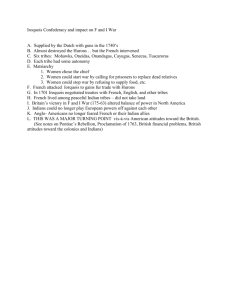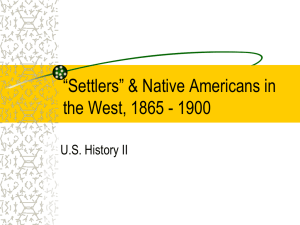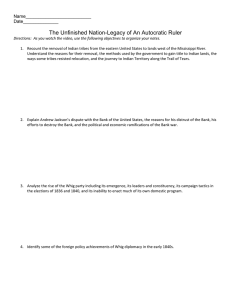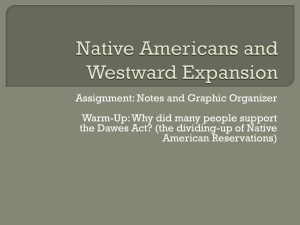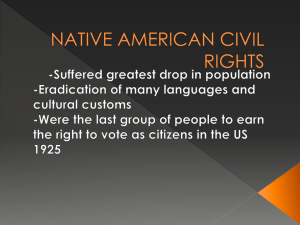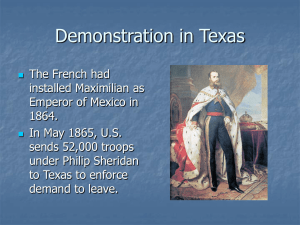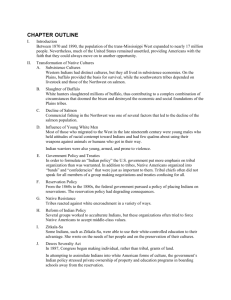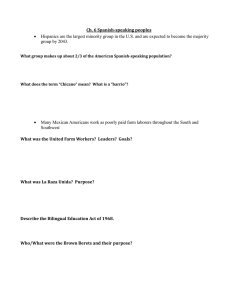The Anthropometric History of Native Americans, c. 1820-1890
advertisement
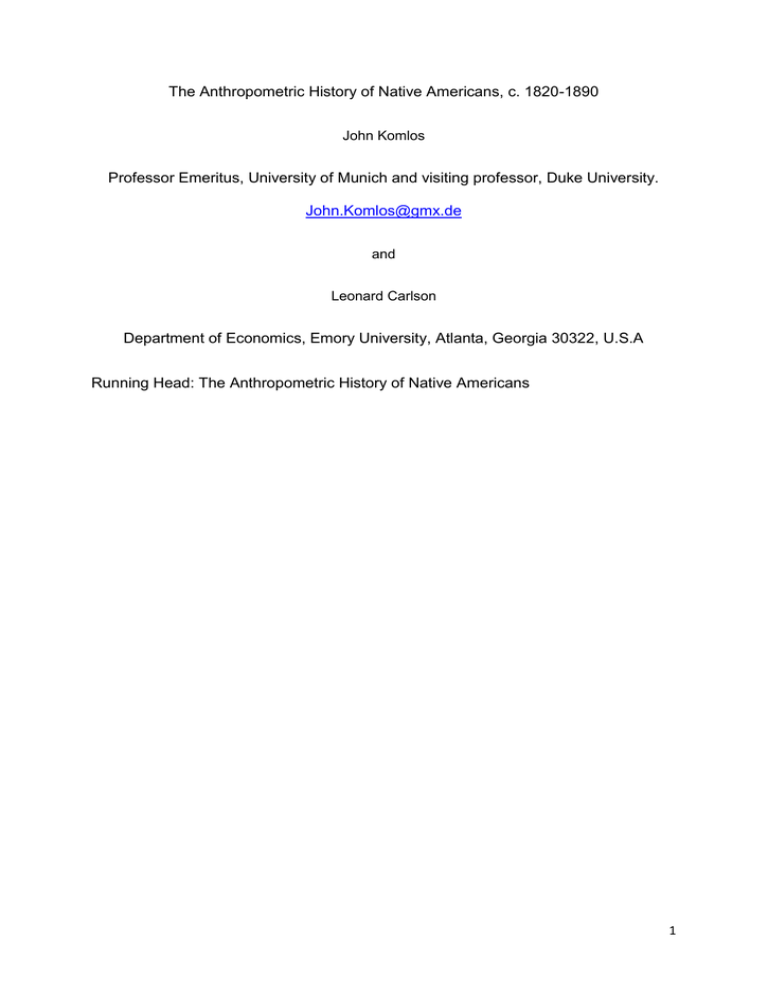
The Anthropometric History of Native Americans, c. 1820-1890 John Komlos Professor Emeritus, University of Munich and visiting professor, Duke University. John.Komlos@gmx.de and Leonard Carlson Department of Economics, Emory University, Atlanta, Georgia 30322, U.S.A Running Head: The Anthropometric History of Native Americans 1 Abstract The trend of the height of Indian scouts in the U.S. Army born between ca. 1825 and 1875 is analyzed. Their average height of ca. 170 cm (67 in.) confirms that natives were tall compared to Europeans but were nearly the shortest among the rural populations in the New World. The trend in their height describes a slightly inverted ”U” shape with an increase between those born 1820-34 and 1835-39 of ca. 1.8 cm (0.7 in.) (p=0.000) and a subsequent slight decline after the Civil War. This implies that they were able to maintain and perhaps even improve their nutritional status through the Civil War, though harder times followed for those born thereafter. We also recalculate the heights of Native Americans in the Boas sample and find that the Plains Indians were shorter than most rural Americans. The trend in the height of Indians in the Boas sample is similar to that of the Scouts. Acknowledgment: We thank Richard Jantz for providing a copy of the “Boas sample.” 1. Introduction 2 Our knowledge of the material conditions of Native Americans in the 19th century is quite limited because of the scarcity of evidence. To be sure, we do know that there was a massive disruption of their way of life and a large decline in population following European contact. The North American Indian population (not just in the US) declined from 1,894,350 in a.d. 1500 to 530,000 in 1900 due to epidemics and other factors [Ubalker 1988]. Since 1900 native population has rebounded and exceeds its level in 1500. Available evidence on their physical stature, however, does enable us to gain at least a glimpse of one important aspect of their biological welfare in the course of much of the 19th century. Human height is a widely used synthetic indicator of nutritional status, malnutrition, and biological living standards in many different settings, including but not limited to underdeveloped economies, in historical contexts, and in circumstances in which economic indicators are either unreliable or scarce as among slaves or Native Americans (Steckel 1995). Physical stature is positively correlated with net nutrition - the balance between the quantity and quality of nutrient intake and the demands on those resources by the human organism for growth, metabolic maintenance, work, and for resistance to diseases. Of course, individual heights depend as much on genetic potential as on nutrition, but at the population level environmental factors play a very substantial role in determining adult height (Bogin 1999). Hence, height of a population is eminently suitable to ascertaining the nutritional and epidemiological circumstances in which that population lived prior to reaching adulthood. We analyze a newly collected data set on the heigth of Native American scouts in the U.S. army. Our paper is organised as follows: in section 2 we discuss prior estimates of the height of Native Americans; in section 3 we explain the 3 regression technique we use in order to estimate mean of samples in which the height distributions are biased, i.e., are not normally distributed; in section 4 we focus on the history of Indian scouts in the U.S. army; in section 5 we present the newly discovered data; in section 6 we report the results of the analysis of these data; in section 7 we discuss our findings; in section 8 we connect with the history of Native Americans in light of our findings; and in section 9 we conclude. 2. Prior estimates of the Height of the Native Population of North America The main source on the height of North American natives hitherto analyzed was collected by the prominent anthropologist Franz Boas at the end of the 19 th century (Boas, 1895; Jantz 1995). Boas published the height distributions by tribe without noticing, however, that the samples were obviously biased insofar as the distributions were not symmetric as expected: there were almost always too few men in the sample left of the mean (or mode) (1895: 372). This is particularly evident among the Sioux and Crow, two tribes with the largest sample sizes which biased the averages in an upwardly direction (Figures 1 and 2). While a random sample of heights is always and everywhere normally distributed, the height samples of both of these tribes clearly suffer from a shortfall below c. 170 cm. Figures 1 and 2 about here Although Jantz did state quite explicitly that “Boas’s samples of Native Americans cannot be regarded as random samples…” (1995), Steckel and Prince analyzed the Boas data set as though it were a random sample, concluding that the Plains Indians were the tallest populations in the world with a mean height of 172.6 cm (68.0 in) (Table 1 row 10) (Steckel, 2010: 267; Steckel & Prince, 2001: 289; 4 Prince & Steckel, 2003: 367). As a consequence of the sampling biases, this estimate is certainly too high (Table 1 row 17). Of the c. 1,700 observations that stem from tribes with a mean height above 170 cm, nearly two-thirds were from tribes whose height distribution did not pass the test of normality.1 If one excludes these tribes from the Boas averages, the mean height becomes 169.6 cm (66.8 in) or about 3.0 cm (1.2 in) below the Steckel-Prince estimates (Table 1, row 23). Of the eight tribes they included in their analysis 72% were from the Sioux and Crow with biased samples, but the height distribution of many of the others are also similarly distorted 2 (Figure 3). In other words, the mean height of Boas sample has to be calculated using techniques that account for the distorted nature of the sample: truncated regression, which has not been used up to now. Figure 3 and Table 1 about here 3. Truncated Regression3 Statistical analysis of height data from non-random samples is facilitated considerably by the biological law that height is approximately normally distributed within a population, and its standard deviation is practically constant, i.e., has a narrow range between ca. 6 and 7 cm among males and between ca. 5.3 and 6.5 cm among females even though mean heights can vary by as much as 20 cm within a population over time (Cole, 2003; Komlos & Baur, 2004). Consequently, variations in a population’s nutritional status affect mean heights, and not the form or dispersion of the distribution. Height samples are frequently not representative of the population from which they are drawn, i.e., they are not random samples. Thus, the Boas sample as well as the scout sample about to be examined are hardly unique in this regard. The height 5 distributions drawn from many historical military records (prior to the introduction of universal conscription) typically have a shortfall in the left tail,- fewer than expected observations - insofar as most armies imposed a minimum height requirement (Komlos, 2004). Thus, data are frequently available only for those individuals whose height exceeded the minimum height requirement (). In such cases, sample means and variances are biased estimators of the underlying population parameters, as are the coefficients of independent variables estimated by ordinary least squares regression (Komlos, 2003; Komlos & A’Hearn, 2004). Suppose that we observe the latent normal random variable Y* with mean and variance 2: y* , ~ N (0, ) only if y* . Thus, sample Y is: y if y 2 ; y missing otherwise. We observe y only if , or . Thus, conditional on being in the sample, E() 0, and is not normally distributed. Parametric methods for estimating build on the normal distribution of heights, enabling us to use the normal density as the likelihood function for (untruncated) heights. In the case of truncation, the area under the curve no longer integrates to unity without the lower tail. To correct for this, we can divide by the probability of being in the sample, i.e. Pr(y ) . This is the standard way to model conditional probability as it normalizes the area under the curve to unity. The probability density function (pdf) of a truncated normal random variable is: 1 y f (y) 1 if y ; f(y) = 0 if y < . (Eq. 1) where denotes the standard normal pdf (Ruud 2000, Ch. 28; Greene 1993, Ch. 22). The log likelihood function of Eq. (1) can be formed and the parameter values 6 that maximize it can be calculated using numerical methods. This maximum likelihood (ML) estimator has the usual ML properties of consistency, and asymptotic efficiency. However, experience with actual samples demonstrated that the ML estimates can vary implausibly over time or cross-sectionally. This inference is based on the fact that there are biological limits to the variability in the physical stature of a population in the short run. The variability turns out to be particularly pronounced if sample sizes are small, if is close to the mode, or perhaps even to the right of it, or if it has been incorrectly identified. For this reason, it has been demonstrated that truncated regression is often more accurate if the standard deviation of the sample height distribution is simultaneously constrained to be the modern value (among men) of ca. 6.86 cm (2.7 in). The constrained truncated regression estimator with sigma thus constrained is frequently more reliable and has greater precision (A’Hearn 2004). As a consequence, we run the truncated regressions4 two ways: a) allowing the program to determine the standard deviation of the height distribution freely, and b) constraining the standard deviations to be 6.86 cm. We refer to the former estimates as unconstrained and to the latter one as constrained. 4. Indian Scouts in the U.S. Army When Congress authorized a force of 1,000 Indian scouts in 1866, the U.S. Army began for the first time to formally include Indians in the military (Dunlay, 1982: 44). The use of scouts was the continuation of a long history of Indians serving as auxiliary troops or as allies fighting alongside American or other nations’ soldiers against enemy tribes. The years 1866 to1890 marked the end of warfare between 7 Indians and the United States. Most of the roughly 270,000 Indians in the United States at that date were at peace5 (Utley, 1973:5). Why were Indians willing to serve in the army or ally themselves with the American forces? Typically Indians saw themselves first as members of families, then clans, then a tribe, but they often saw members of other tribes as different from themselves and with good reason. Enemy tribes often raided for horses or slaves from neighbors; there were battles over territory, and revenge raids to retaliate for murdered relatives (Utley, 1973:5). Thus, serving with the American army did not necessarily create a moral dilemma for Indian scouts. Hostile Indians’ mobility and familiarity with the terrain made guerilla warfare effective and it sometimes required large numbers of troops to confront relatively small numbers of fighters. In such warfare, Indian scouts provided vital services as guides and interpreters. After 1866 the army was often assigned the task of confining Indian tribes to defined lands “reserved” for Indians – reservations. Typically this was done by signing a treaty, with a tribe ceding tribal territory in return for the right to a reduced territory and goods to be provided by the federal government. For plains tribes in this era there was continuing pressure on the key resource – the bison herds. By the late 1870s the bison herds had largely been depleted and most plains tribes depended upon food issued by the government and lived in encampments near the agency. Even after they were defeated and confined to reservations, however, bands of Indians would occasionally leave the reservation and were then subject to capture by the army who would return them. Battles in this period often represented last ditch stands by Indians who did not want to move to a reservation.6 While fighting in the northern plains and Rocky Mountain States was greatly diminished after 1880, fighting continued in the southwestern territories of Arizona, 8 New Mexico, and Texas until 1886 with the surrender of the Apache warriors led by the leader known to whites as Geronimo. General George Crook, perhaps the most able of the military leaders fighting in the West, found it essential to recruit Apaches to fight the hostile members of the same tribe (Utley, 1973: 378). The continued warfare in the Southwest is probably why Arizona is the most common state of origin for scouts in the sample about to be analyzed. 5. Data on Indian Scouts By the 19th century most military in economically advanced countries (including the US) recorded the height of soldiers in order to have a physical description in case of desertion and in order to document that the soldier met the height requirements. Height requirements were imposed inasmuch as short men were at a disadvantage in hand-to-hand combat and exceptionally tall men were not suitable for the cavalry on account of the high center of gravity. In order to estimate the height of Native American men, data on the height of scouts were extracted from the National Archives (N=12,999) (Table 2).7 Information available includes height, age, state of birth, date of enlistment, and occupation prior to enlistment. Indians were eminently suitable as scouts because they knew the local terrain the best. The minimum and maximum height requirement to be eligible to be in the U.S. military also applied to scouts.8 We do not know about other possible requirements, but assume that within the acceptable range of heights the men were a random sample from their respective population. The distribution of adult heights is perfectly normal between the range of 66-75 inches. Outside of this range there does appear to be an obvious shortfall9 (Figure 4).The fact that the distributions are normal enables us to use truncated regression in order to correct for the height restrictions. The use of 9 truncated regression enables us to infer the height of the general population of Indian men from that of the scouts. Figure 4 about here A few of the observations were obviously inaccurate or hastily recorded and were excluded from the working data set. These 247 scouts did not have their name recorded as did the others, but were given numbers instead, which gives the impression that their information might not have been carefully recorded.10 This impression was reinforced by the fact that the height values were uniformly repeated for these persons (almost always at 68 inches) implying that the records were not based on actual measurements. We also excluded those who were born outside of the U.S. Scouts who were between the ages of 21 and 49 (inclusive) are considered adults and those older were also excluded in the analysis. Youth –those aged 19-20– were also included in one of the models. Table 2 about here We first examined the height distributions by recruitment year (annually) in order to ascertain the minimum height requirements; we found that for some years the distributions are far from normally distributed – even above the minimum height requirement. This implies that the measurements were done carelessly in those years with too many observations in the 68 inch bin. Hence, the data for those years were excluded from further analysis.11 It became clear that very tall scouts were also fewer in number than expected. The minimum and maximum height requirements were determined by enlistment year annually,12 because of the obvious substantial variation in the apparent recruiting practices. The minimum and maximum height requirements do not pose an insurmountable problem, though, because the use of 10 truncated regression compensates for these deficiencies of the sample. After excluding those outside of the acceptable range of height requirements, the size of the working adult data set becomes 6,524; with the inclusion of youth the sample size is 6,899. The main analysis pertains to U.S.-born adult Indian men. We then supplement the data to include youth and compare the results to those obtained from the Boas sample. 6. Results The regressions control for the state of provenance as well as for the occupation of the scouts to the extent these are available (Table 3). In Figure 5 we show a more detailed depiction of the trends of the heights of the scouts than in table 3 (10 instead of 7 periods). There are few statistically significant spatial variations: scouts from Montana are consistently shorter than average while those from the Midwest are consistently taller (Figure 6). However, none of the estimated coefficients of the occupation variables is consistently significant.13 Table 3 and Figures 5 and 6 about here The estimated time trend indicates the following pattern (Figure 5 and Table 3): 1) there was a marked (and statistically significant) increase in height among those born in the second half of the 1830s. The increase in height between those born 1820-34 and 1835-39 was ca. 1.8 cm (0.7 in.)14 (p=0.000); 2) after the 1830s there was very little change in height, though a shallow maximum seems to have been reached around the 1860 birth cohorts; the increase in this period was an insignificant ¼ inch (0.6 cm); 3) this was followed by a statistically insignificant diminution in height of about ¼ inch (0.6 cm) among the 1870s birth cohort; 4) the constrained and unconstrained estimates are very close to one another and track 11 each other well; the average gap between them is a mere 0.4 cm (0.15 in.) with the constrained estimates being consistently smaller; 5) the inclusion of the youth makes very little difference (these results are not reported in the graph); 6) the estimates obtained on the basis of the Boas sample fit into this general pattern extremely well both in terms of levels as well as the trend (N=4,430). The estimated level of their height is on average ¼ inch (0.6 cm) below the (constrained) estimates of the scouts and run parallel to it. The trend estimated on the basis of the Boas sample also has a slightly inverted “U” shape even if it is statistically insignificant; the method of estimation was to use truncated regression in which 170 cm (67 in) was the lower limit at which shortfall begins for the Crow and Sioux. If we confine the analysis to the 8 tribes on which Steckel & Prince concentrated, the estimated mean height becomes 170.6 cm (67.2 in.) or 2 cm (0.8 in) below the Steckel & Prince estimate (Table 1 line 17). 7. Discussion The correspondence of the estimated average height of the army scouts with that of the civilians in the Boas sample is quite remarkable both in their levels and trends. The Indians (rows 21 & 23 Table 1) were about as tall as the white Americanborn cavalrymen (row 20). This is somewhat misleading, however, because the whites are representative of the U.S. population at large with 10% of the sample born in New England and 43% urban, whereas the Indians were mostly from the West and none was urban. This makes a considerable difference insofar as rural populations were much taller during that period. This is also the reason why the white cavalrymen appear to be shorter than the other men reported in Table 1. None of the other samples are representative of the population at large in the post-Civil War era. Rather, they either pertain to elite income groups, or refer to an earlier birth cohort or 12 are regionally limited.15 The white cavalrymen are the only spatially representative sample for the U.S. for the time. Hence, it is safe to infer that the Indians were shorter than the rural white population in the West. However, the Indian men were quite tall in international comparison throughout the period under consideration (Table 1). At 170 cm (66.9 in) they were taller than European populations (Table 1 rows 22 and 24). However, given the abundant nutrients in the New World, it is not appropriate to compare their height to that of Europeans. Given the rural and agricultural nature of Indian society, it is also inappropriate to compare their stature to the US average either, insofar as a considerable proportion of the white population lived in towns whose dwellers were considerably shorter than average. Hence, it is more appropriate to compare Indian heights to groups that were similarly engaged in rural occupations such as U.S. farmers. Such a comparison with most of the available data indicates that the Native Americans tended to be near the bottom end of the U.S. rural height distribution (Table 1).16 This is also true for Indian women in the Boas sample: they were shorter than most rural Americans (Table 4). The only shorter group among men was African Americans after emancipation (Table 1, row 24). The men were even shorter than the free African Americans in Maryland, who were certainly at the bottom of the socioeconomic distribution. The Plains Indians were not the tallest by any means (Table 1, row 17) as argued in Steckel (2010); they were about as tall as the free blacks of Maryland (Table 1, row 16). One can plausibly infer from this evidence that the nutritional status and biological standard of living of Native Americans was on average closer to those of the poorer segments of the U.S. rural population. Their main advantage compared to the urban population was the lower disease incidence due to the lower population density as well as the propinquity to nutrients. 13 Table 4 about here The unique slightly concave trend in both the scout and Boas samples implies that there was probably some improvement in their nutritional status in spite of their military defeat and subsequent tribulations. The constancy and perhaps even slight increase in height of the scouts in the late 1830s also implies that they did not experience the “Antebellum Puzzle” as did most of the white population. That puzzle refers to the shrinking of the average height of the American population in a prosperous period of economic expansion during the pre-Civil War decades. The explanation of declining size at a time when incomes were growing has been controversial. While some scholars argued that the decline was due to an increase in the incidence of diseases, others argued that the nutritional intake of the population declined, because of a diminution in calorie and protein intake associated with the rise in the absolute and relative food prices (Komlos 1987). The estimated trend of the height of Indians corroborates other findings which showed that there were several groups in the society whose height did not decline at all or even increased among the cohorts born in the late 1830s. These groups were typically those who either did not purchase their food in the market, such as slaves, self-sufficient farmers, or who had sufficient income to compensate for the increase in food prices. Thus, the heights of the economic elites were also unaffected by the increases in food prices. They had sufficient income to retain their nutritional status, while the slaves were paid efficiency wages in nutrients so that they, too, remained protected from the rise in food prices. Similarly, the Indians were not buying nutrients so that agricultural prices would not have affected their nutritional status either. This is another indication that the Antebellum Puzzle was primarily anchored in the agricultural economy rather than in changes in the disease environment, insofar as 14 diseases would not have spared these disparate social groups within the population: the very rich as well as the most unfortunate. Since scouts were drawn from a variety of tribes, we look at different parts of the country in order to illuminate the above results. As discussed in what follows, there are reasons to believe that these years were hard for Indians in general. At the risk of oversimplifying (since each tribe has a unique history), we can divide the West into different regions and consider what was happening in each. These are the northern Great Plains, Oklahoma, and the Indian Territory, the southern Great Plains, the Southwest, and the Great Basin and Pacific Northwest. With respect to anthropometric history, the most studied group of nineteenthcentury American Indians are the Plains Indians (Prince, 1995). Steckel (2010) and Hämäläinen (2003) show that while plains tribes adapted many similar cultural elements, some tribes were more successful than others. According to Hämäläinen (2003: 430), “Horses did bring new possibilities, prosperity, and power to Plains Indians, but they also brought destabilization, dispossession, and destruction. The transformational power of horses was simply too vast.” Prince (1995) finds a pattern of rising heights among the Plains Sioux (combining the Yankton and Teton [Lakota] branches of the tribe) from 1820 to1880, similar to the one found here, except his data do not show a downward turn in heights in the 1870s, as does this sample. Hämäläinen argues that the Lakota were exceptionally successful among plains tribes. The traditional explanation for their success in challenging white settlers and the federal government is a large population “and organizational capability.” In addition, Hämäläinen argues that the “Lakota also became so dominant because they succeeded… [at] finding a functional equilibrium among horse numbers, ecological constraints, and economic, cultural, and military imperatives” (859). 15 Other tribes were not doing as well. For example, the Crow tribe was further west and was fully equestrian (no longer lived in fixed villages) by the 1820s, but the tribe was at war with many other tribes over horses and territory. As a result, the Crow were more often on the edge of starvation than were the Sioux and ended up allying themselves with the American army in wars with other tribes. Tribes in the extreme North, such as the Blackfeet, were constrained by poorer weather and at times lacked adequate grass to get their horses through the winter alive (Hämäläinen, 2003: 852-3). Tribes that combined fixed settlements and agriculture with hunting, such as the Pawnee and Osage, remained at risk for raids by the mounted plains tribes in the 1850s (Hämäläinen, 2003: 856-8). The post-Civil War period saw the accelerated destruction of the bison herds and a rapid decline in the ability of the northern plains tribes to sustain themselves. “By 1877, after only a few fights with the U.S. Army, all northern tribes were confined on reservations on both sides of the forty-ninth parallel [the border with Canada]” (Hämäläinen 2003: 853). After that date, battles on the plains consisted of desperate fights by small groups of warriors leaving the reservations. Once they were on reservations, Indians began to achieve modest success as farmers (Carlson, 1981, 1992). 8. Notes on the History of Native Americans The results presented here conclude that broadly speaking, there was an improvement in the standard of living of Indian scouts from the 1830’s through the American Civil War, followed by a decline there after. Scouts were drawn from a variety of tribes in different parts of the country, who would have had unique living standard. As shown in what follows there are ample reasons to believe that tribes in different parts of the country would have found the 1830’s difficult, followed by an improvement. 16 The Indian Territory (Oklahoma): In the second quarter of the nineteenth century the dominant policy towards Indians in the U.S. is known as the Removal Policy. Many tribes in the East were pressured to sign treaties exchanging their land in the East for new lands west of the Mississippi River. This was seen as a way to open Indian lands to white settlers while giving Indians protected territories in the West. It was an uneasy compromise between whites who wanted Indian land and those who wanted to protect Indian rights and perhaps encourage assimilation (Prucha, 1984:179-181). The most famous cases of removal were those of the southern tribes, but it also applied to tribes north of the Ohio River who had relatively small populations and were less well organized than tribes south of the Ohio River. The five largest southern tribes - Cherokee, Choctaw, Chickasaw, Creek, and Seminoles - were collectively known as the “Five Civilized Tribes” since they were agricultural and had adapted more European customs and technology. These tribes were forced from the Southeast in the years from 1820 to 1840 and received larger amounts of land in the Indian Territory (what is today Oklahoma), where they established self-governing republics. The Creek, Chickasaw and Choctaw moved within two years of the passage of the removal Act of 1830 (Berrington, 1998: 19). The largest tribe was the Cherokee, who were forced out of Georgia in 1838-9 during the so-called “Trail of Tears.” Prior to removal the Cherokee had achieved self sufficiency on farms in Georgia and North Carolina (Wishart, 1995). These eastern tribes are labeled as “immigrant tribes” on the map of major tribes taken from Utley (2003) (Figure 7). After arriving west of the Mississippi, these tribes suffered raids from powerful plains tribes and some, notably the Cherokee and Creek, from internal disputes. The initial decades in Oklahoma were difficult. Presumably as these tribes became adjusted to their new homes and developed 17 farms, conditions would have improved until 1865. This might account for the rise in average heights among recruits. During the U.S. Civil War, some factions of these Oklahoma tribes sided with the South and some with the North. But most of the organized tribal governments had southern sympathies; at the end of the war the tribes were stripped of territory in western Oklahoma which was turned into reservations for southern plains tribes. Figure 7 about here Southern Plains and Texas: In the early nineteenth century, the southern plains were dominated by the Comanche. They developed an important trade network in which they acquired and sold horses. The growth in the number of horses led to differences in wealth - with wealthy men having large herds of horses and several wives. However, the large herds placed a strain on the grazing resources available to the tribe. The Comanche formed an alliance with the Kiowa and dominated the southern plains into what is today northern Mexico through the 1820s, raiding as well as trading with other tribes and Mexican and American settlements. By the 1850s drought and the opening of overland trails led to a drastic decline in bison herds and led to periodic famines in the southern Great Plains. The population of the Comanche declined from roughly 20,000 in the 1820s to roughly 5,000 in the 1860s (Hämäläinen, 2003: 844-45). This is reflected in the shorter stature of Comanche men (Prince & Steckel, 2003: 367; Steckel 2010). The Southwest: In the early nineteenth century the territory that is today Arizona and New Mexico (as well as several other western states) was part of Mexico. Some of the tribes in this region, particularly the Navajo, Apache, and Comanche, raided Mexican settlers, the agricultural tribes (such as the Pueblos and Yuma), and more nomadic tribes (the Ute) for goods, slaves, and horses. These 18 tribes had horses and could trade with American traders for highly effective weapons. The Mexican government was never able to effectively contain these warlike tribes. Agricultural tribes allied themselves with the Mexicans and later the Americans in battles with the Navajo and other tribes (Lamar & Truett, 1996). In 1848 the U.S. annexed a large territory, including Arizona and New Mexico, from Mexico at the end of the Mexican-American War. The U.S. Army took over control of the sparsely settled region as well as taking over the frontier of Texas. Like the Mexican army had done, American troops built a series of forts and outposts to contain the raiders. In the thinly settled, harsh landscape, small bands of hostile Indians were able to evade the poorly paid and trained U.S. Army (Utley, 1973: 16383). To deal with this, the U.S. increased its military presence in the region. This increased military presence could have led to better conditions for peaceful tribes after 1848, although there would have been more pressure on warlike tribes including the Navajo. The Navajo remained a major military threat until about 1864, when they were defeated and confined to a reservation in southern New Mexico, Bosque Redondo, where conditions were harsh and the tribe survived on food provided by the U.S. Army. Four years later the Navajo moved to a new reservation nearer their original home territory and remained at peace with the Americans thereafter (Prucha, 1984: 451-53). Warfare continued in the Southwest until 1886. Tribes used the border with Mexico as a barrier. Tribes who moved into northern Mexico raided into the U.S. and tribes based in the U.S. raided northern Mexico (Utley, 1973: 344-98). The Great Basin and Pacific Northwest: According to table 2, only 277 Indians in the sample came from Idaho or Oregon and some of these would have been from nomadic tribes that had adapted to the arid Great Basin region. Since 19 there were relatively few of these Indians in the sample, it is likely that they do not influence the pattern of heights in these data. Indians from Montana and Wyoming might be Crow, a mounted equestrian tribe who were often at war with neighboring tribes and would have been part of the struggle for control of the northern plains. Further west, tribes such as the Klamath had an economy based on hunter-gatherer existence that fit the more arid plateau. It is not surprising that they might have a poorer diet. The most famous fights in the Great Basin involved small desperate bands resisting being confined to reservations (Utley, 1973: 323). 9. Conclusion Both the levels and trends estimated in this new sample are quite similar to the ones obtained from the Boas sample of Indians collected at the end of the 19th century. The trend describes a slightly inverted “U” shape with some increase in the late antebellum period and a slight subsequent decline after the Civil War. This implies that in spite of their considerable tribulations, the Native Americans were able to maintain and to some extent possibly even improve their nutritional status through the Civil War, though harder times followed for those born thereafter. We find that the tallest Indian scouts were born during the American Civil War (1861-65). Western settlement by whites greatly declined during the war, which reduced the pressure on tribal resources and exposure to diseases carried by migrants. This would have led to favorable conditions throughout much of Indian country. As discussed, the early 1860s saw the end of an intense campaign against the Navajo and their confinement on an arid reservation in southern New Mexico. It is possible that the pressure on the Navajo reduced the stress felt by other native groups in the 1850s and that the decline after the 1860s reflects the impact of the military defeat on the Navajo in particular. 20 The end of the Civil War saw an increased rate of white settlement in the West and would have placed added pressure on tribes for resources, as well as exposure to disease. The federal government began the first transcontinental railroad in 1863, during the war, and finished it in 1867. This split the bison herds and opened the way for their commercial slaughter as a source of leather. Settlers and miners also moved west to states like Colorado and Montana that previously had few white settlements. The bison herds on the northern plains were largely destroyed by white and Indian hunters by the 1870s, which greatly limited the food supplies of the Plains Indians. The finding that the shortest Indian scouts were from Montana is consistent with the difficulties faced by Indians there. Many of them lived in villages and the men also used horses to hunt bison. Such villagers were exposed to raids by enemy tribes when the men went hunting. The Pawnee had a long tradition of fighting along with the U.S. military in wars against their enemies (Dunlay, 1982: 148). Other village tribes that combined hunting bison with village agriculture by women include the Ponca, Omaha, and Iowa. Similarly, scouts from the Midwest and Arkansas could also be from tribes that were exposed to raids by plains tribes. Indian scouts from Oregon may be from the more nomadic tribes in the Great Basin who faced a harsh environment. In sum, the height of the Indian scouts serving in the U.S. Army confirm that American natives were relatively tall in international comparison as they were taller than almost all European populations at the time with the exception of elite groups such as the British gentry (Komlos, 2007a). While at first glance this might appear to be surprising for a disadvantaged and poor minority population, the pattern appears less of a conundrum considering that they were living in close proximity to the land 21 which tended to confer considerable nutritional advantages over urban populations throughout the world in the 19th century (Komlos, 2003). That the proximity to the source of food conferred biological advantages has been found in many other data sets: "the tallest men in the Habsburg monarchy were born in the economically least developed lands.... Although technologically backward, the peasants were self-sufficient and lived on productive land that was not densely populated" (Komlos, 1985: 1156); “The fact that Swedes from the northern provinces born before 1850 were substantially taller than their more southern... compatriots accords well with the status of the North as a frontier region, lightly populated and devoted to hunting and raising animals” (Sandberg & Steckel, 1987), and similarly for the United Kingdom: “The tall-but-poor anomaly also holds for other isolated pre-industrial populations”17 (Nicholas & Steckel, 1997: 115). “Town dwellers, however, were generally at a disadvantage for procuring nutrients because they were farther from the source of food supply, and, unlike the rural population, were not paying farm-gate prices for agricultural products” (Komlos, 1998: 790).18 In short, the nutritional status of Native Americans was commensurate with their preindustrial life style. To be sure, the food subsidies from the government must have contributed to the maintenance of their biological welfare. However, the Indian men in both the scout and the Boas samples were among the shortest groups of the rural populations in the New World. Their height was closer to that of the urban populations who experienced a much heavier disease load than the Indians living in a low population density environment. One might characterize the implication of their height as rural poverty in the New World which still provided considerable advantages in terms of nutritional status in international comparison. 22 23 Acknowledgement: This paper was written while John Komlos was a fellow of the National Humanities Center. 24 References A’Hearn, B. (2004). A restricted maximum likelihood estimator for truncated height samples. Economics and Human Biology, 2(1), 5-19. A’Hearn, B. (1998). The Antebellum Puzzle Revisited: A New Look at the Physical Stature of Union Army Recruits during the Civil War. In: Komlos, J. & Baten, J. (Eds.), Studies on the Biological Standard of Living in Comparative Perspective, Stuttgart: Franz Steiner Verlag, pp. 250-267. Anders, G.C. (1981). The Reduction of a Self-Sufficient People to Poverty and Welfare Dependence: An Analysis of the Causes of Cherokee Indian Underdevelopment. American Journal of Economics and Sociology, 40(3), 225-237. Barrington, L. (Ed.), (1998). The Other Side of the Frontier: Economic Explorations into Native American History, Westview Press, Boulder, CO. Boas, F. (1895). Zur Anthropologie der nordamerikanischen Indianer. Zeitschrift für Ethnologie, 27, 366-411. Bogin, B. (1999). Patterns of Human Growth. Cambridge: Cambridge University Press, 2nd edition. Carlson, L. (1981). Indians, Bureaucrats and Land: The Dawes Act and the Decline of Indian Farming, Greenwood Press, Westport, CT. Carlson, L. (1992). Learning to Farm: Indian Land Tenure and Farming Before the Dawes Act. In: Anderson, T. (Ed.), Property Rights, Constitutions and Indian Economies, Rowan and Littlefield, pp. 67-83. Carson, S. (2008). The Effect of Geography and Vitamin D on African American Stature in the Nineteenth Century: Evidence from Prison Records. The Journal of Economic History, 68(3), 812-831. 25 Carson, S. (2009). African-American and White Inequality in the 19th Century American South: A Biological Comparison. Journal of Population Economics, 22(3), 757-772. Cole, T.J. (2003). The secular trend in human physical growth: a biological view. Economics and Human Biology, 1(2), 161-168. Cuff, T. (2005). The Hidden Cost of Economic Development: The Biological Standard of Living in Antebellum Pennsylvania. Aldershot, U.K., and Burlington, Vt.: Ashgate Publishing. Greene, W. (1993). Econometric Analysis, 2nd ed. Englewood Cliffs, NJ: PrenticeHall. Dunlay, T.W. (1982). Wolves of the Blue Soldiers: Indian Scouts and Auxiliaries with the United States Army, 1860-1890. Lincoln, University of Nebraska Press. Hämäläinen, P. (2003). The Rise and Fall of Plains Indian Horse Cultures. The Journal of American History, 90(3), 833-862. Jantz, R.L. (1995). Franz Boas and Native American Biological Variability. Human Biology, 67(3), 345– 353. Komlos, J. (1985). Stature and Nutrition in the Habsburg Monarchy: The Standard of Living and Economic Development. American Historical Review, 90(4), 1149-61. Komlos, J. (1987). The Height and Weight of West Point Cadets: Dietary Change in Antebellum America. The Journal of Economic History, 47(4), 897–927. Komlos, J. (1998). Shrinking in a Growing Economy? The Mystery of Physical Stature during the Industrial Revolution. Journal of Economic History, 58(3), 779-802. 26 Komlos, J. (1992). Toward an Anthropometric History of African Americans: The Case of the Free blacks in Antebellum Maryland. In: Goldin, C. & Rockoff, H. (Eds.), Strategic Factors in Nineteenth-Century American Economic History: A Volume to Honor Robert W. Fogel, Chicago: University of Chicago Press, pp. 297–329. Komlos, J. (2003). Access to Food and the Biological Standard of Living: Perspectives on the Nutritional Status of Native Americans. American Economic Review, 93(1), 252-255. Komlos, J. (2004). How to (and How Not to) Analyze Deficient Height Samples: an Introduction. Historical Methods, 37(4), 160-173. Komlos, J. (2007a). On British Pygmies and Giants: the Physical Stature of English Youth in the 18th and 19th Centuries. Research in Economic History, 25, 117136. Komlos, J. (2007b). Anthropometric Evidence on Economic Growth, Biological Well Being, and Regional Convergence in the Habsburg Monarchy, 1850 – 1910. Cliometrica, 1(3), 211-237. Komlos, J. & A’Hearn, B. (2004). On the Bias-Precision Tradeoff: A Practical Guide to Use of the Restricted Maximum Likelihood Estimator in Historical Height Samples. University of Munich, Department of Statistics, Sonderforschungsbereich 386, Discussion paper 370, January. Komlos, J. & Baur, M. (2004). From the Tallest to (One of) the Fattest: The Enigmatic Fate of the Size of the American Population in the Twentieth Century. Economics and Human Biology, 2(1), 57-74. Lamar, H. & Truett, S. (1996). Greater Southwest and California to the 1880s. In: Trigger, B.G. & Wilcomb, W. (Eds.), The Cambridge History of the Native 27 Peoples of the Americas, vol. I, North America, Part 2, New York: Cambridge University Press, pp. 57-116. National Archives and Records Administration, Washington, D,C, Register of Enlistments in the U,S, Army, 1798-1914, Record Group RG094, Microfilm ID M233, Indian Scouts, 1866ff. Nicholas, S. & Oxley, D. (1993). The Living Standards of Women during the Industrial Revolution, 1795-1820. The Economic History Review, 46(4), 723-749. Nicholas, S. & Steckel, R.H. (1997). Tall but Poor: Living Standards of Men ad Women in Pre-famine Ireland.” Journal of European Economic History, 26(1), 105-136. Prince, J. M. (1995). Intersection of Economics, History, and Human Biology: Secular Trends in Stature in Nineteenth-Century Sioux Indians. Human Biology, 67(3), 387-406. Prince, J.M. & Steckel, R.H. (2003). Nutritional Success on the Great Plains: Nineteenth-Century Equestrian Nomads. Journal of Interdisciplinary History, 33(3), 353-384. Prucha, F.P. (1984). The Great Father. Lincoln: University of Nebraska Press. Ruud, P. (2000). An Introduction to Classical Econometric Theory. Oxford: Oxford University Press. Sandberg, L. & Steckel, R.H. (1987). Heights and Economic History: The Swedish Case.” Annals of Human Biology, 14(2), 101-109. Steckel, R.H. (2010). Inequality Amidst Nutritional Abundance: Native Americans on the Great Plains. Journal of Economic History 70(2), 265-286. Steckel, R.H. (1995). Stature and the Standard of Living. Journal of Economic Literature, 33(4), 1903-1940. 28 Steckel, R.H. & Prince, J.M. (2001). Tallest in the World: Native Americans of the Great Plains in the Nineteenth Century. American Economic Review 91(1), 287-294. Sunder, M. (2007). Passports and economic development: an anthropometric history of the U.S. Elite in the 19th Century. Unpublished Ph.D. Dissertation, University of Munich. Sunder, M. (2004). The height of Tennessee convicts: another piece of the antebellum puzzle. Economics and Human Biology, 2(1), 75–86. Ubelaker, Douglas (1988). “North American Indian Populations Size, A.D. 1500 to 1985.” American Journal of Physical Anthropology 77: 289–294. Utley, R.M. (1973). Frontier Regulars: The United States Army and the Indian 1866-1891. New York, Macmillan Publishing. Utley, R.M. (2003). The Indian Frontier, 1846-1890. Revised Edition, Albuquerque: University of New Mexico Press. Wishart, D. (1995). Evidence of Surplus Production in the Cherokee Nation Prior to Removal. Journal of Economic History, 55(1), 120-138. Zehetmayer, M. (2011). The continuation of the antebellum puzzle: stature in the US, 1847–1894. European Review of Economic History, 15(2), 313–327. 29 Figure 1. Height (cm) Distribution of Sioux Men 50 45 40 35 30 25 N=527 20 15 10 5 0 154 156 159 161 163 165 167 169 171 173 175 177 179 181 183 185 188 193 Figure 2. Height (cm) Distribution of Crow Men 20 18 16 N=198 14 12 10 8 6 4 2 188 186 184 182 180 178 176 174 172 170 168 166 164 162 160 158 0 30 18 Figure 3. Heigth (cm) Distribution of Arapaho Men 16 Frequency (%) 14 12 10 N=61 8 6 4 2 193 191 189 187 185 183 181 179 177 175 173 171 169 167 165 163 161 159 0 Figure 4. Height (inches) Distibution of Scouts 18 16 Frequency (%) 14 N=7504 12 10 8 6 4 2 0 58 60 61 62 63 64 65 66 67 68 69 70 71 72 73 74 75 31 Figure 5. Estimated Height of Indian Men 67.5 171.1 67.0 170.1 inches 168.1 cm 169.1 66.5 66.0 167.1 Constrained 65.5 Unconstrained 166.1 Boas Sample 65.0 1820 165.1 1830 1840 1850 Birth Cohort 1860 1870 32 Figure 6. Height of Scouts by State of Birth 67.6 67.4 67.2 67.0 66.8 66.6 66.4 66.2 66.0 65.8 65.6 33 Figure 7. Major Indian Tribes in 1850 Source: Utley (2003: 5) 34 1 2 3 4 Table 1. Height of Males c. mid-19th century Group cm inch date, type source U.S. Elite 175.0 68.9 1860s Sunder, 2007 Tennessee, white 174.5 68.7 1850s convicts Sunder, 2004 Georgia, farmers 174.3 68.6 1850s convicts Komlos & Coclanis, 1997 Texas, white 174.0 68.5 1860s convicts Carson, 2009 5 Australia 173.9 68.5 1860s Whitwell et al., 1997 6 Union Army soldiers 173.5 68.3 1840s farmers A'Hearn, 1998 173.1 68.1 1840-80 Steckel and Prince, 2001 7 Crow (Boas sample) a 172.9 68.1 1840-80 Steckel and Prince, 2001 8 Sioux (Boas sample) 172.7 68.0 1850s convicts Sunder, 2004 9 Tennessee, blacks Plains Indians 172.6 68.0 1840-80 Steckel and Prince, 2001 10 172.2 67.8 1840s urban A'Hearn, 1998 11 Union Army soldiers 172.2 67.8 1840 convicts Komlos & Coclanis, 1997 12 Georgia, blacks 172.1 67.8 1860s Steckel & Haurin, 1994 13 Ohio Nat'l Guard Texas, black 171.9 67.7 1860s Carson, 2009 14 171.6 67.6 1860s Komlos, 1987 15 West Point cadets 170.7 67.2 1830s rural Komlos, 1992 16 Maryland, free black b 170.6 67.2 1840-80 Own Caculations 17 Plains Indians 170.6 67.2 1850s Komlos & Coclanis, 1997 18 Georgia, black c 170.2 67.1 1840-80 Own Caculations 19 Sioux (Boas sample) 170.2 67.0 1860s Zehetmayer, 2011 20 US cavalry a 170.0 66.9 1840-80 Own calculations 21 Indians (Boas sample) 170.0 66.9 1860s This sample 22 Indian scouts d 169.6 66.8 1840-80 Own calculations 23 Indians (Boas sample) 169.4 66.7 1860s farmers Carson, 2008 24 African Americans 169.2 66.6 1840s Cuff, 2005 25 Philadelphia 166.0 65.4 1870s Komlos, 2007b 26 Austria a Non-normal distribution indicates sample selection bias. b Estimated from the Boas Sample restricted to the 8 plains tribes analyzed by Steckel and Prince using restricted truncated regression with lower limit of 170 cm for the Sioux and Crow tribes. c Mean calculated with constrained truncated regression with lower limit of 170 cm. d Estimated using restricted truncated regression with lower limit of 170 cm for the Sioux and Crow tribes. a 35 Table 2. Characteristics of the Indian Scout Sample Working Full Sample Sample N % N % Ages 17-18 232 1.8 144 1.8 19-20 737 5.7 435 5.3 21 1,055 8.1 658 8.0 22-24 2,476 19.0 1,564 19.1 25-49 8,302 63.9 5,285 64.6 >49 166 1.3 92 1.1 Missing 31 0.2 0 0.0 12,999 100.0 8,178 100.0 Chief 35 0.3 14 0.2 Farmer 845 6.5 540 6.6 Herder 124 1.0 83 1.0 Hunter 1,366 10.5 813 9.9 209 1.6 159 1.9 Scout 5,860 45.1 3,558 43.5 Other 4,560 35.1 3,008 36.8 Arizona 5854 45.0 3,876 47.4 Arkansas 158 1.2 103 1.3 1,964 15.1 1,449 17.7 Idaho 100 0.8 73 0.9 Indian Territory 727 5.6 437 5.3 Minnesota 122 0.9 82 1.0 Montana 635 4.9 363 4.4 Nebraska New Mexico Oregon Texas United States Wyoming Other U.S. Mexico Other Foreign Date of Birth <1830 1830s 1840s 1850s 1860s 665 530 177 296 130 258 617 708 58 5.1 4.1 1.4 2.3 1.0 2.0 4.7 5.4 0.4 491 362 112 197 68 176 389 0 0 6.0 4.4 1.4 2.4 0.8 2.2 4.8 0.0 0.0 227 985 3,394 5,129 2,798 1.7 7.6 26.1 39.5 21.5 224 879 2,082 2,947 1,846 2.7 10.7 25.5 36.0 22.6 Total Occupation Rancher State of Birth Dakota 36 >1869 Missing 447 19 3.4 0.1 200 0 2.4 0.0 Note: this table includes those who were excluded because they were shorter than the minimum height requirement. Source: National Archives and Records Administration, Washington, D,C, Register of Enlistments in the U,S, Army, 1798-1914, Record Group RG094, Microfilm ID M233, Indian Scouts 1866ff. 37 Table 3. Truncated regression. Dependent Variable: Height (inches) of Indian Scouts. Robust Robust Robust Coef. Std. Err. Coef. Std. Coef. Std. Err. Err. Birth cohort 0.19 0.18 0.19 1820-34 -0.91 -0.89 -0.86 0.18 0.16 0.18 1835-39 -0.19 -0.24 -0.14 0.15 0.14 0.15 1840-44 -0.12 -0.16 -0.07 0.13 0.12 0.13 1845-49 -0.06 -0.11 -0.02 0.12 0.11 0.12 1850-54 -0.22 -0.27 -0.07 1855-69 Reference Reference Reference 0.40 0.36 0.34 >1870 -0.22 -0.18 -0.07 Provenance 0.13 0.12 0.13 Arizona 0.15 0.12 0.15 0.38 0.35 0.37 Arkansas 0.07 0.08 0.10 0.21 0.19 0.20 IndianTer. 0.11 0.08 0.16 Dakota Reference Reference Reference 0.28 0.25 0.27 Montana -0.60 -0.52 -0.57 0.31 0.29 0.30 Midwest 0.60 0.56 0.69 0.22 0.20 0.21 Nebraska 0.14 0.16 0.18 0.23 0.21 0.22 NewMexico 0.27 0.25 0.25 0.40 0.40 Other 0.58 Coef. 0.49 0.52 0.26 0.24 0.25 South 0.25 0.21 0.31 0.23 0.21 0.22 West 0.00 0.00 -0.02 0.30 0.28 0.28 Wyoming 0.12 0.03 -0.26 Occupation 0.17 0.16 0.17 Farmer -0.12 -0.12 -0.16 0.14 0.13 0.14 Hunter 0.26 0.27 0.19 0.38 0.35 0.36 Herder 0.67 0.59 0.74 0.33 0.30 0.31 Rancher 0.29 0.32 0.47 Other Reference Reference Reference Age 0.33 age19 -0.10 0.22 age20 -0.17 Adult Adults only Adults only Reference 0.12 0.11 0.12 Constant 66.96 67.13 66.91 N 6524 6524 6899 method Constrained Unconstrained Constrained Sigma 2.68 2.43 2.68 Wald chi2 45.00 49.42 47.43 Prob>chi2 0.002 0.000 0.002 Note: coefficients significant at the 5% level are in bold type 38 Table 4. Height of Females c. mid-19th century Group 1 U.S. Elite 2 Georgia, white 3 Georgia, blacks 4 Texas, white 5 6 7 8 9 10 11 12 13 14 Texas, black Sioux (Boas sample) Tennessee Crow Maryland, black English, rural Indians (Boas sample) Irish Maryland, black English, urban cm inches date, type source 163.6 163.3 161.4 161.1 64.4 64.3 63.6 63.4 1860s convicts convicts convicts Sunder, 2007 Komlos & Coclanis, 1997 Komlos & Coclanis, 1997 Carson, African American 161.1 160.6 160.0 159.1 158.0 156.8 156.7 155.4 155.4 154.3 63.4 63.2 63.0 62.6 62.2 61.8 61.7 61.2 61.2 60.8 convicts 1870s Convicts 1870s 1840s rural c.1800 convicts 1860s c.1800 convicts 1840s urban c.1800 convicts Carson, African American Steckel & Prince, 2001 Sunder, 2004 Steckel & Prince, 2001 Komlos, 1992 Nicholas & Oxley, 1993 Own calculations Nicholas & Oxley, 1993 Komlos, 1992 Nicholas & Oxley, 1993 39 Endnotes 1 For instance, for the Sioux sample the Kolmogorov-Smirnov test rejected normality at the 0.006 level and the Shapiro-Wilk test rejected it at the 0.02 level. 2 Furthermore, among the Cheyenne 41% of the recorded height of men were between 173 and 176 cm (68.1-69.3 in), which is highly implausible in a normal distribution (Boas, 1895: 368). 3 This section draws extensively on Komlos and A’Hearn 2004. 4 IC-STATA version 10. 5 According to Utley there were less than 100,000 “hostile” Indians in 1866. Peaceful tribes had either chosen to accommodate themselves to the American presence, had already been defeated, or had been so terrorized by other tribes and disease that they did not have the strength to fight. 6 An example is the famous flight of the Nez Perce and Chief Joseph who were trying to escape into Canada. The last armed conflict of the Indian wars occurred in 1890 - the massacre by cavalry soldiers of Sioux Indians camped at Wounded Knee, South Dakota. The Indians who were camped there believed in the messianic ghost dance religion. 7 All extant observations were recorded. 8 The lower and upper limits are as follows: 1866(67:70), 1868(65:74), 1870(66:72), 1871(66:74), 1872(63:74), 1873(60:74), 1874(60:69), 1875(66:71), 1876, (66:69) 1877(66:70), 1878(64:68), 1879(67:73), 1880(66:71), 1882(63:76), 1883(60:70), 1885(64:75), 1886(66:70), 1887(62:73), 1888(66:73), 1889(66:73), 1891(64:70), 1892(66:72), 1894(64:72), 1896(66:72). Note that 0.01 inch was subtracted from the lower limit and 0.99 was added to the upper limit in order to retain observations on the height requirements. 40 9 The number of observations of this distribution does not equal the number noted in the regression on account of the fact that the regressions do not include data outside of the range required to be accepted into the military. 10 These 247 are not included in Table 2. 11 The number of observations thus excluded is 2,343 adults and 202 youth. These years are 1867, 1869, 1881, 1884, 1890, 1893, 1895, and >1996. 12 See footnote 8. 13 Only heights of men from Nebraska and Arkansas as well as those of herders were significant. They were consistently less than the average, but there were few observations in those categories in the sample (Table 2). 14 This specification includes adults only, with unconstrained estimation. With constrained estimation the increase is 0.81 inches (p=0.000). 15 Rows 1 and 15) pertain to elites, 2-4, 9, 12, 14, 18) pertain to southerners and to convicts; both groups were taller than average; 6) pertains to an earlier period; 7-8, 13) were calculated incorrectly; 11, 16) is for an earlier period when men were taller; 17, 19) pertain to those living near bison herds. 16 While men in some tribes in the Boas sample were markedly taller than average, this was due to the fact that the samples were not random and taller men were more likely to be selected for the Boas sample. 17 “The situation of poor, isolated population being taller than a wealthy, more commercial population was not, then, unique to the Irish-English comparison” (Nicholas and Steckel, 1997, p. 115; See also Shay, 1994, Mokyr and O’Grada, 1994, Baten, 1996). 18 “Individuals who bought their food had to pay for transportation costs and for the efforts of middlemen, whereas subsistence farmers did not” (Komlos, 1989, p. 97). 41
